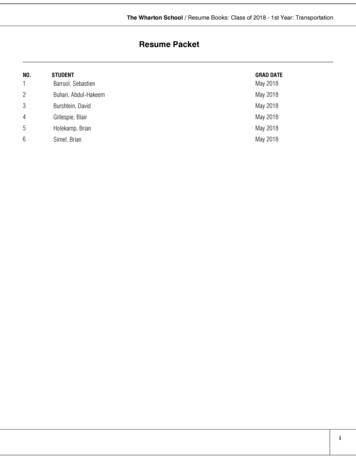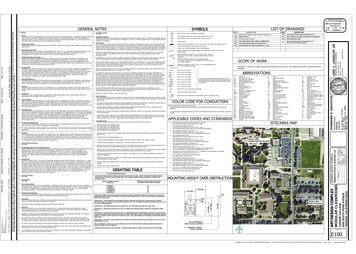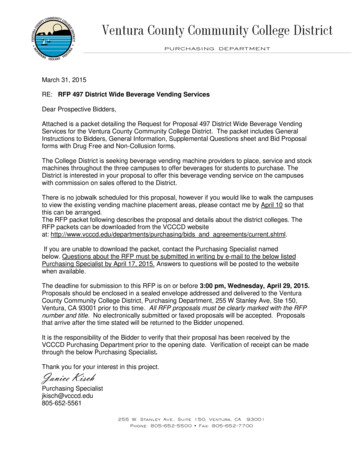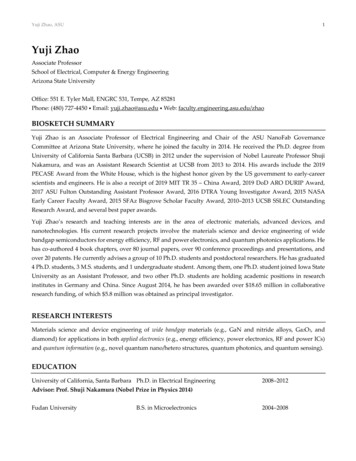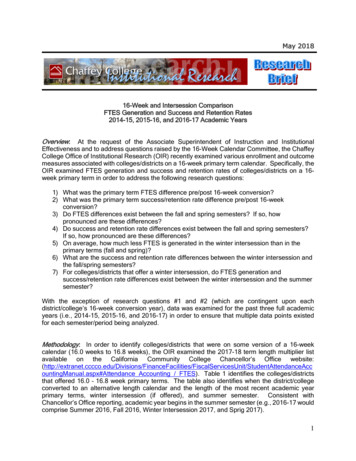
Transcription
May 201816-Week and Intersession ComparisonFTES Generation and Success and Retention Rates2014-15, 2015-16, and 2016-17 Academic YearsOverview: At the request of the Associate Superintendent of Instruction and InstitutionalEffectiveness and to address questions raised by the 16-Week Calendar Committee, the ChaffeyCollege Office of Institutional Research (OIR) recently examined various enrollment and outcomemeasures associated with colleges/districts on a 16-week primary term calendar. Specifically, theOIR examined FTES generation and success and retention rates of colleges/districts on a 16week primary term in order to address the following research questions:1) What was the primary term FTES difference pre/post 16-week conversion?2) What was the primary term success/retention rate difference pre/post 16-weekconversion?3) Do FTES differences exist between the fall and spring semesters? If so, howpronounced are these differences?4) Do success and retention rate differences exist between the fall and spring semesters?If so, how pronounced are these differences?5) On average, how much less FTES is generated in the winter intersession than in theprimary terms (fall and spring)?6) What are the success and retention rate differences between the winter intersession andthe fall/spring semesters?7) For colleges/districts that offer a winter intersession, do FTES generation andsuccess/retention rate differences exist between the winter intersession and the summersemester?With the exception of research questions #1 and #2 (which are contingent upon eachdistrict/college’s 16-week conversion year), data was examined for the past three full academicyears (i.e., 2014-15, 2015-16, and 2016-17) in order to ensure that multiple data points existedfor each semester/period being analyzed.Methodology: In order to identify colleges/districts that were on some version of a 16-weekcalendar (16.0 weeks to 16.8 weeks), the OIR examined the 2017-18 term length multiplier listavailable on the California Community College Chancellor’s Office ccountingManual.aspx#Attendance Accounting / FTES). Table 1 identifies the colleges/districtsthat offered 16.0 – 16.8 week primary terms. The table also identifies when the district/collegeconverted to an alternative length calendar and the length of the most recent academic yearprimary terms, winter intersession (if offered), and summer semester. Consistent withChancellor’s Office reporting, academic year begins in the summer semester (e.g., 2016-17 wouldcomprise Summer 2016, Fall 2016, Winter Intersession 2017, and Sprig 2017).1
Table 1: Districts/Colleges With 16-Week Primary Term CalendarsDistrictAntelope CCDCabrillo CCDCitrus CCDCoast CCDCompton CCDDesert CCDEl Camino CCDGavilan CCDGlendale CCDImperial CCDKern CCDLong Beach CCDLos Angeles CCDMt. San Antonio CCDNorth Orange County CCDOhlone CCDPalomar CCDPasadena Area CCDRancho Santiago CCDRedwoods CCDRio Hondo CCDRiverside CCDSan Diego CCDSan Jose-Evergreen CCDSanta Barbara CCDSanta Clarita CCDSanta Monica CCDSierra CCDSiskiyou CCDSouthwestern CCDVictor Valley CCDWest Valley-Mission CCDYosemite CCDCollegeAntelope ValleyCabrilloCitrusCoastlineGolden WestOrange CoastComptonCollege of the DesertEl CaminoGavilanGlendaleImperial ValleyBakersfieldCerro CosoPortervilleLong BeachEast Los AngelesLA CityLA HarborLA MissionLA PierceLA SouthwestLA Trade TechLA ValleyWest Los AngelesMt. San AntonioCypressFullertonOhlonePalomarPasadena CitySanta AnaSantiago CanyonCollege of the RedwoodsRio HondoMoreno ValleyNorcoRiversideSan Diego CitySan Diego MesaSan Diego MiramarEvergreen ValleySan Jose CitySanta BarbaraCollege of the CanyonsSanta MonicaSierra CollegeCollege of the SiskiyousSouthwesternVictor ValleyMissionWest ValleyColumbiaModestoSource: http://datamart.cccco.edu/Courses/Academic Calendar.aspxYearStartedon 16 .416.4Length ofWinterIntersession5 WeeksNot Offered6 Weeks4 Weeks4 Weeks4 Weeks6 Weeks3 Weeks6 Weeks4 Weeks6 Weeks5 WeeksNot OfferedNot OfferedNot Offered5 Weeks5 Weeks5 Weeks5 Weeks5 Weeks5 Weeks5 Weeks5 Weeks5 Weeks5 Weeks6 Weeks4 Weeks4 WeeksNot OfferedNot OfferedNot Offered4 Weeks4 Weeks5 Weeks4 Weeks6 Weeks6 Weeks6 WeeksNot OfferedNot OfferedNot OfferedNot OfferedNot OfferedNot Offered5 Weeks6 WeeksNot Offered4 WeeksNot Offered6 Weeks4 Weeks4 WeeksNot OfferedNot OfferedLength ofSummerSemester8 Weeks8 Weeks8 Weeks10 Weeks10 Weeks10 Weeks8 Weeks9 Weeks8 Weeks6 Weeks10 Weeks6 Weeks12 Weeks12 Weeks12 Weeks10 Weeks11 Weeks11 Weeks11 Weeks11 Weeks11 Weeks11 Weeks11 Weeks11 Weeks11 Weeks6 Weeks8 Weeks8 Weeks8 Weeks12 Weeks8 Weeks8 Weeks8 Weeks12 Weeks6 Weeks5 Weeks5 Weeks5 Weeks10 Weeks10 Weeks10 Weeks6 Weeks6 Weeks12 Weeks11 Weeks9 Weeks8 Weeks9 Weeks4 Weeks8 Weeks10 Weeks10 Weeks15 Weeks15 Weeks2
As table 1 illustrates, in the 2017-18 academic year 33 districts (45.8% of the community collegedistrict’s statewide) and 54 colleges (47.4% of the community college’s statewide) hadChancellor’s Office approved academic calendars that offered 16-week primary terms. Amongthese districts/colleges, 23 districts (31.9% of the community college district’s statewide) and 37colleges (32.5% of the community college’s statewide) offered a winter intersession.For the purposes of the current study some districts/colleges were excluded from further analysesfor a variety of factors. Since one of the goals of the current study is to examine differences inFTES generation, districts/colleges that offered a 16-week primary term but had a Chancellor’sOffice approved term length multiplier (TLM) of 17.0 were excluded since the TLM impacts allcensus procedure attendance accounting formulas. Additionally, analyses were further restrictedto colleges/districts that were comparable in size to Chaffey College ( /- 33% unduplicatedstudent headcount, based upon Fall 2017 semester enrollment). Districts/colleges with extremeanomalies (e.g., College of the Redwoods is the only institution that offered a winter intersessionthat started in December (12/17/17) and ended in mid-January (01/12/18); Columbia and ModestoColleges in the Yosemite CCD offers summer semesters (15 weeks) that are almost as long asthe primary terms (16.4 weeks)) were also excluded from analyses. Finally, districts/colleges thatcounted winter intersession days towards the 175-day minimum instructional day requirementwere excluded from analyses. Regardless of their status relative to the aforementioned criteria,in order to examine districts/colleges that were geographically similar all contiguousdistricts/colleges were retained for analyses. Applying the aforementioned criteria, Table 2illustrates which districts/colleges were retained for analyses; these districts/colleges arehighlighted in green. In total, 18 colleges representing 12 districts were retained for analyses.FTES data for identified districts/colleges was obtained through the Chancellor’s Office DataMart.As reported in DataMart, “the FTES value is calculated by summing “Total Hours” (MIS deriveddata element SXD4 “Total-Hours”) in all enrollment records reported to the California CommunityCollege Chancellor’s Office MIS during the requested period, then dividing by 525. If total hourscannot be derived because data is missing or set to “Unknown/Unreported,” the enrollments arenot included. All activity in classes eligible for state apportionment funding is included. Thismethodology is not the same as the methodology used in calculating FTES for CCFS-320 report.”Due to the reporting periods and methodology employed, some differences in FTES calculationmay exist. Furthermore, MIS data is only as accurate as the integrity checks and reviewprocesses established by each individual district/college.To identify success and retention rates, DataMart data was once again used. Success andretention rate calculations are based upon MIS data element SX04 (Enrollment-Grade).Consistent with operational definitions employed by the California Community CollegeChancellor’s Office, success rate is defined as the number of A, B, C, or P grades earned onrecord divided by the total number of valid grades earned on record (i.e., all A, B, C, D, F, FW, P,NP, I, or W grades). Similarly, retention rate is defined as the number of A, B, C, D, F, FW, P, NPor I grades earned on record divided by the total number of valid grades earned on record (i.e., allA, B, C, D, F, FW, P, NP, I, or W grades).3
Table 2: 16-Week Districts/Colleges – Reason for Excluding From Further AnalysesDistrictAntelope CCDCabrillo CCDCitrus CCDCoast CCDCompton CCDDesert CCDEl Camino CCDGavilan CCDGlendale CCDImperial CCDKern CCDLong Beach CCDLos Angeles CCDMt. San Antonio CCDNorth Orange County CCDOhlone CCDPalomar CCDPasadena Area CCDRancho Santiago CCDRedwoods CCDRio Hondo CCDRiverside CCDSan Diego CCDSan Jose-Evergreen CCDSanta Barbara CCDSanta Clarita CCDSanta Monica CCDSierra CCDSiskiyou CCDSouthwestern CCDVictor Valley CCDWest Valley-Mission CCDYosemite CCDCollegeAntelope ValleyCabrilloCitrusCoastlineGolden WestOrange CoastComptonCollege of the DesertEl CaminoGavilanGlendaleImperial ValleyBakersfieldCerro CosoPortervilleLong BeachEast Los AngelesLA CityLA HarborLA MissionLA PierceLA SouthwestLA Trade TechLA ValleyWest Los AngelesMt. San AntonioCypressFullertonOhlonePalomarPasadena CitySanta AnaSantiago CanyonCollege of the RedwoodsRio HondoMoreno ValleyNorcoRiversideSan Diego CitySan Diego MesaSan Diego MiramarEvergreen ValleySan Jose CitySanta BarbaraCollege of the CanyonsSanta MonicaSierra CollegeCollege of the SiskiyousSouthwesternVictor ValleyMissionWest ValleyColumbiaModestoReason(s) Excluded From AnalysesFall 2017WinterHeadcountIntersessionGreater Than17.0Counted inOffering /- 33%TLM175-Day Min. XXXXXXXXXXX4
Research Question #1: What was the primary term FTES difference pre/post 16-weekconversion?The academic year that each district/college converted to an alternative calendar is reported intables 3 and 4. In table 3, FTES generated during the fall/spring semesters of the conversationyear is compared to the FTES generated in the fall/spring semesters of the preceding year.Similarly, table 4 compares FTES generated in the conversion academic year (SU, FA, WI, andSP) to FTES generated in the preceding academic year (SU, FA, and SP).Table 3: Fall & Spring Semester FTES Change, Pre/Post Calendar ConversionCollegeBakersfieldCitrusCypressEl CaminoFullertonLA CityLA PierceLA Trade TechLA ValleyMoreno ValleyMt. San AntonioNorcoOrange CoastPalomarPasadena CityRiversideSan Diego MesaVictor 947,267Fall Semester ,142-5474,212-4,4827,081-186Spring Semester 878-4,2697,4267,071-355Table 4: Annual FTES Change, Pre/Post Calendar ConversionCollegeBakersfieldCitrusCypressEl CaminoFullertonLA CityLA PierceLA Trade TechLA ValleyMoreno ValleyMt. San AntonioNorcoOrange CoastPalomarPasadena CityRiversideSan Diego MesaVictor ,94723,19917,92915,07419,05116,452Annual 258-2,245-407-9,009-1405
As tables 3 and 4 suggest, districts/colleges that converted to an alternative calendar exhibited awide range of experiences in post-conversion FTES generation. Excluding two colleges that werenewly approved and initially started on a 16-week calendar (Moreno Valley and Norco), nine ofthe sixteen colleges examined experienced increases in fall semester FTES generation whileeight of the sixteen colleges experienced increases in spring FTES generation. Furthermore, itshould be noted that the economic climate associated with the varied conversion periods andeach district/colleges internal enrollment management practices also likely had an impact onpre/post FTES generation. Finally, one district/college – Victor Valley – was an extreme anomaly.The extremely high pre-FTES generation for a district/college this size suggests some possibleerrors or anomalies in 2003-04 MIS reporting. Excluding Victor Valley, the aggregate postconversion FTES generated in the Fall semester (7,272) was higher than pre-conversion Fallsemester FTES (7,172), an average difference of 100 FTES (1.39%). Applying similar filters toSpring semester data, post-conversion Spring FTES (7,218) was slightly lower than preconversion Spring FTES (7,311), on average 93 FTES lower (-1.27%).Examining data by pre/post conversion academic year and excluding Moreno Valley, Norco, andVictor Valley, larger differences in FTES generation were identified. Excluding these threecolleges, on average the remaining fifteen colleges generated an average of 16,711 FTES in theirfirst year on an alternative calendar. In comparison, these fifteen colleges generated an averageof 16,278 FTES in the academic year preceding calendar conversion, a difference of 433 FTES(2.66%).Research Question #2: What was the primary term success/retention rate difference pre/post16-week conversion?Employing the aforementioned operational definitions to examine student performance outcomes,table 5 examines fall and spring semester success rates prior to/after conversion to an alternativecalendar while table 6 examines pre/post conversion retention rates.Table 5: Fall & Spring Semester Success Rates, Pre/Post Calendar ConversionCollegeBakersfieldCitrusCypressEl CaminoFullertonLA CityLA PierceLA Trade TechLA ValleyMoreno ValleyMt. San AntonioNorcoOrange CoastPalomarPasadena CityRiversideSan Diego MesaVictor 965.94Fall 4.80n/a66.5070.7168.1360.3866.6658.9966.12Spring 6462.1069.9163.3970.64 .54-0.09-1.04-0.942.58-0.796
Table 6: Fall & Spring Semester Retention Rates, Pre/Post Calendar ConversionCollegeBakersfieldCitrusCypressEl CaminoFullertonLA CityLA PierceLA Trade TechLA ValleyMoreno ValleyMt. San AntonioNorcoOrange CoastPalomarPasadena CityRiversideSan Diego MesaVictor 082.61Fall /a80.0991.4284.3482.1580.2480.5982.45Spring 41n/a-1.23n/a-0.88-0.55-0.63-1.12-0.144.130.12As table 5 indicates, slightly lower success rates were observed in both the Fall and Springsemesters following alternative calendar conversion. In the fall semester, eleven of the sixteencolleges for which valid data existed (68.8%) experienced a decline in success rates, ranging fromnegligible (-0.04%) to much larger (-8.38%) differences. Similarly, thirteen of the sixteen collegesexamined (81.3%) experienced pre/post conversion declines in spring semester success rates,ranging from -0.16% to -4.82%. Overall, fall semester success rates declined from 65.94% to65.26% (-0.68%) while spring semester success rates declined from 66.12% to 65.33% (-0.79%).While slight college-specific and overall success rate declines were observed in both the fall andspring semester, slight improvements were observed in retention rates. Nine of the sixteencolleges examined experienced increases in fall semester retention rates with gains in retentionranging from 0.09% to 3.91%. Examining the spring semester, six of the sixteen collegesexperienced increases in retention rates, ranging from 0.37% to 4.13%. Overall, fall semesterretention rates rose from 82.61% to 83.23% ( 0.62%) while spring semester retention rates rosefrom 82.45% to 82.56% ( 0.12%).7
Research Question #3: Do FTES differences exist between the fall and spring semesters? If so, how pronounced are thesedifferences?Table 7: Fall/Spring FTES Differences – 2014-15, 2015-16, and 2016-17Fall/Spring Semester FTES DifferencesCollegeBakersfieldCitrusCypressEl CaminoFullertonLA CityLA PierceLA Trade TechLA ValleyMoreno ValleyMt. San AntonioNorcoOrange CoastPalomarPasadena CityRiversideSan Diego MesaVictor 7.4-324.13-YrFA 2.211,376.36,805.17,124.14,166.16,960.73-YrSP 96.1Examining data for the past three academic years, the eighteen comparison colleges that employ 16-week primary terms experiencedslightly lower FTES generation in the spring semester than in the fall semester. On average, over the past three fall semestersexamined the comparison colleges generated an average of 6,960.7 FTES in the fall semester. In the spring semester, collegesgenerated a three-year average of 6,664.6 FTES, approximately 296.1 less FTES (-4.25% in the spring semester). Only two colleges(Bakersfield and San Diego Mesa) generated more FTES on average in the spring semesters than in the fall semesters.Comparing Chaffey College’s current fall/spring FTES generation patterns, the past three fall semesters have generated an average of6,986.52 resident FTES, while the past three spring semesters have generated an average of 6,550.91 FTES, a three-year averagedifference of 435.61 FTES (-6.24% in the spring semester). Only four of the eighteen alternative calendar colleges examined in thecurrent study exhibited a higher fall/spring semester FTES difference: Cypress (10.39% difference), Los Angeles Valley (9.15%difference), Mt. San Antonio (6.83% difference), and Victor Valley (6.67% difference).8
Research Question #4: Do success rate differences exist between the fall and spring semesters? If so, how pronounced are thesedifferences?Table 8: Fall/Spring Success Rate Differences – 2014-15, 2015-16, and 2016-17Fall/Spring Semester Success Rate DifferencesCollegeBakersfieldCitrusCypressEl CaminoFullertonLA CityLA PierceLA Trade TechLA ValleyMoreno ValleyMt. San AntonioNorcoOrange CoastPalomarPasadena CityRiversideSan Diego MesaVictor 20.813-YrFA YrSP 320.781.100.46-0.030.760.77-0.720.71Examining success rates over the past three full academic years, fourteen of the eighteen comparison colleges examined (77.8%)exhibited higher spring than fall semester success rates. Among the eighteen comparison colleges, the largest fall/spring success ratedifference was 2.28% (Bakersfield) while the lowest fall/spring semester success rate differences was -0.72% (Victor Valley). Overall,the average three-year spring semester success rate (68.98%) was 0.71% higher than the average three-year fall semester successrate (68.27%). Over the past three full academic years, the average fall semester success rate at Chaffey College was 69.65% whilethe average spring semester success rate was 71.10%, a 1.45% difference in fall/spring semester success rate.9
Research Question #4: Do retention rate differences exist between the fall and spring semesters? If so, how pronounced are thesedifferences?Table 9: Fall/Spring Retention Rate Differences – 2014-15, 2015-16, and 2016-17Fall/Spring Semester Retention Rate DifferencesCollegeBakersfieldCitrusCypressEl CaminoFullertonLA CityLA PierceLA Trade TechLA ValleyMoreno ValleyMt. San AntonioNorcoOrange CoastPalomarPasadena CityRiversideSan Diego MesaVictor -1.11-0.63-1.63-1.230.18-0.52-0.353-YrFA YrSP ning retention rates over the past three full academic years, twelve of the eighteen comparison colleges examined (66.7%)exhibited lower spring than fall semester retention rates. Among the eighteen comparison colleges, the largest fall/spring retention ratedifference was 0.72% (Los Angeles valley) while the lowest fall/spring semester retention rate differences was -1.49% (Citrus). Overall,the average three-year fall semester retention rate (86.03%) was 0.26% higher than the average three-year spring semester retentionrate (85.77%). Over the past three full academic years, the average fall semester retention rate at Chaffey College was 91.28% whilethe average spring semester retention rate was 90.65%, a 0.63% difference in fall/spring semester retention rate.10
Research Question #5: On average, how much less FTES is generated in the winter intersession than in the fall semester?Table 10: Fall Semester/Winter Intersession FTES Differences – 2014-15, 2015-16, and 2016-17Fall Semester/Winter Intersession FTES DifferencesCollegeCitrusEl CaminoLA CityLA PierceLA Trade TechLA ValleyMoreno ValleyMt. San AntonioNorcoPasadena CityRiversideVictor -5,538.0-3,616.4-5,088.73-YrFA Avg3-YrWI Avg3-Yr .6-4,757.75,167.3993.3-4,174.0Restricting analyses to colleges that offered a winter intersession in the past three academic years, twelve colleges were examined.Additionally, two of these colleges – El Camino and Pasadena City College – only recently (2016-17) submitted MIS data for the winterintersession. As a result, these two colleges were excluded from analyses of three-year patterns reducing the number of comparisoncolleges for the remaining research questions to ten.Examining FTES generation for colleges that offered winter intersessions over the past three full academic years, winter intersessionsgenerated significantly less FTES than the fall semester. On average, the ten colleges examined generated 5,680.9 FTES over thepast three fall semesters. For the winter intersession, these colleges generated an average of 923.3 FTES, a difference of 4,757.7FTES (83.75% less FTES). Among the colleges examined, the disparity ranged from -88.79% (Los Angeles Pierce) to -79.67% (Mt.San Antonio College).11
Research Question #5: On average, how much less FTES is generated in the winter intersession than in the spring semester?Table 11: Spring Semester/Winter Intersession FTES Differences – 2014-15, 2015-16, and 2016-17Spring Semester/Winter Intersession FTES DifferencesCollegeCitrusEl CaminoLA CityLA PierceLA Trade TechLA ValleyMoreno ValleyMt. San AntonioNorcoPasadena CityRiversideVictor 5,298.7-3,219.1-4,937.93-YrSP Avg3-YrWI Avg3-Yr 7-4,481.05,022.4993.3-4,029.1Examining FTES generation for colleges that offered winter intersessions over the past three full academic years, winter intersessionsgenerated significantly less FTES than the spring semester. On average, the ten colleges examined generated 5,404.2 FTES over thepast t
San Diego Mesa 02-03 16.5 Not Offered 10 Weeks San Diego Miramar 02-03 16.5 Not Offered 10 Weeks San Jose-Evergreen CCD Evergreen Valley 01-02 16.3 Not Offered 6 Weeks San Jose City 01-02 16.3 Not Offered 6 Weeks Santa Barbara CCD Santa Barbara 03-04 16.0 Not Offered 12 Weeks Santa Clarita CCD College of the Canyons 06-07 16.0 5 Weeks 11 Weeks
